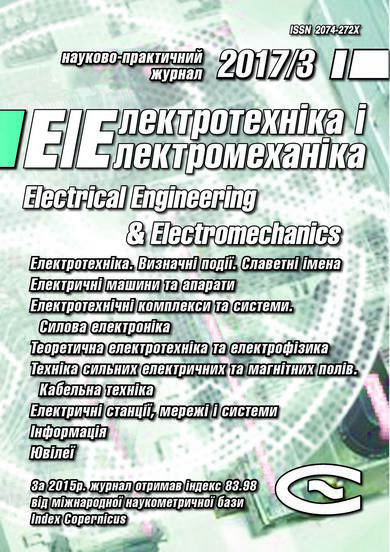A MATHEMATICAL MODEL OF THERMAL POWER PLANTS SMOKE EXHAUSTERS INDUCTION MOTORS SYSTEM OPERATION MODES
DOI:
https://doi.org/10.20998/2074-272X.2017.3.03Keywords:
mathematic model, numerical methods, thermal power plant, induction motorsAbstract
Purpose. Development of a model-software complex (MSC) for computer analysis of modes of the system of induction motors (IM) of smoke exhausters of thermal power plant (TPP), the basic elements of which are mathematical models and corresponding software written in the programming language FORTRAN. Methodology. Mathematical model serves as a system of differential equations of electrical and mechanical condition. The equation of electric state is written in phase coordinates based on Kirchhoff's laws, and mechanical condition described by the d'Alembert equation. Mathematical model focuses on explicit numerical integration methods. Scientific novelty. The equation of state of electrical connections takes into account the mutual electromagnetic circuits for transformer of own needs (TON) and induction motors and interdependence (in all possible combinations) between: TON (from which motors powered) and each of the two IM and blood pressure between themselves. The complex allows to simulate electromagnetic and electromechanical processes in transitional and steady, symmetric and asymmetric modes including modes of self-induction motors. Results. Complex is used for computer analysis of electromagnetic and electromechanical processes and established the basic laws of motion modes of starting, stopping and self-start of IM of smoke exhausters of the TPP unit. Practical value. The complex is suitable for computer analysis of modes of other similar units of own needs of thermal power plants.References
1. Abbasov E.M., Golodnov Iu.M., Zil'berman V.A., Murzakov A.G. Sobstvennye nuzhdy teplovykh elektrostantsii [Own needs of thermal power plants]. Moscow, Energoatomizdat Publ., 1991. 272 p. (Rus).
2. Vasyliv K.M. Metody i modeli analizu protsesiv avtonomnykh system elektrozhyvlennya na bazi asynkhronizovanoho heneratora z bezkontaktnym kaskadnym modul'ovanym zbudzhuvachem. Diss. dokt. techn. nauk [Methods and models for analyzing the processes of autonomous power supply systems based on an asynchronous generator with a noncontact cascade modulated exciter. Doc. tech. sci. diss.]. Kyiv, 2010. 398 p. (Ukr).
3. Kurbangaliev U.K. Samozapusk dvigatelei sobstvennykh nuzhd elektrostantsii [Self-starting engines for power plants own needs]. Moscow, Energoizdat Publ., 1982. 56 p. (Rus).
4. Lahutin V.M., Teptya V.V., Vyshnevs'kyy S.Ya. Vlasni potreby elektrychnykh stantsiy [Own needs of power plants]. Vinnytsya, VNTU Publ., 2008. 102 p. (Ukr).
5. Neklepaev B.N. Elektricheskaia chast' elektrostantsii i podstantsii [Electric part of power plants and substations]. Moscow, Energoatomizdat Publ., 1986. 640 p. (Rus).
6. Plakhtyna E.G. Matematicheskoe modelirovanie elektromashinno-ventil'nykh sistem [Mathematical modeling of electro-machine-valve systems]. Lviv, Vishcha shkola Publ., 1986. 164 p. (Rus).
7. Syromiatnikov I.A. Rezhimy raboty asinkhronnykh i sinkhronnykh dvigatelei [Modes of operation of asynchronous and synchronous motors]. Moscow, Energoatomizdat Publ., 1984. 240 p. (Rus).
8. Fil'ts R.V. Matematicheskie osnovy teorii elektromekhanicheskikh preobrazovatelei [Mathematical foundations of the theory of electromechanical transducers]. Kyiv, Naukova dumka Publ., 1979. 208 p. (Rus).
9. Vasil'eva A.A. Elektricheskaia chast' stantsii i podstantsii [Electrical part of stations and substations]. Moscow, Energoatomizdat Publ., 1990. 576 p. (Rus).
Downloads
Published
How to Cite
Issue
Section
License
Copyright (c) 2017 K. M. Vasyliv

This work is licensed under a Creative Commons Attribution-NonCommercial 4.0 International License.
Authors who publish with this journal agree to the following terms:
1. Authors retain copyright and grant the journal right of first publication with the work simultaneously licensed under a Creative Commons Attribution License that allows others to share the work with an acknowledgement of the work's authorship and initial publication in this journal.
2. Authors are able to enter into separate, additional contractual arrangements for the non-exclusive distribution of the journal's published version of the work (e.g., post it to an institutional repository or publish it in a book), with an acknowledgement of its initial publication in this journal.
3. Authors are permitted and encouraged to post their work online (e.g., in institutional repositories or on their website) prior to and during the submission process, as it can lead to productive exchanges, as well as earlier and greater citation of published work.





